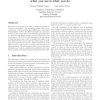10 search results - page 1 / 2 » Learning Sensory-Motor Maps for Redundant Robots |
IROS
2006
IEEE
13 years 10 months ago
2006
IEEE
— Humanoid robots are routinely engaged in tasks requiring the coordination between multiple degrees of freedom and sensory inputs, often achieved through the use of sensorymotor...
TROB
2008
13 years 4 months ago
2008
Affordances encode relationships between actions, objects and effects. They play an important role on basic cognitive capabilities such as prediction and planning. We address the p...
ICRA
2003
IEEE
13 years 9 months ago
2003
IEEE
We propose an approach for a robot to imitate the gestures of a human demonstrator. Our framework consists solely of two components: a Sensory-Motor Map (SMM) and a View-Point Tra...
IROS
2007
IEEE
13 years 10 months ago
2007
IEEE
— We present a new approach to cope with unknown redundant systems. For this we present i) an online algorithm that learns general input-output restrictions and, ii) a method tha...
AAAI
1994
13 years 5 months ago
1994
Table lookup with interpolation is used for many learning and adaptation tasks. Redundant mappings capture the important concept of \motor skill," which is important in real,...

